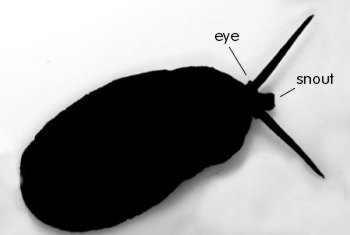
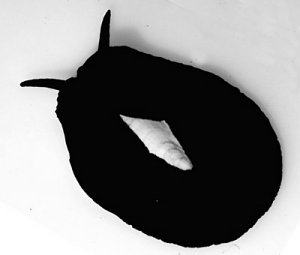
Elephant Slug, Shield Slug, Ducksbill Limpet (Scutus sp.)
Order: VETIGASTROPODA
Superfamily: FISSURELLOIDEA
Family: Fissurellidae
PHOTO
Scutus antipodes, grows to over 12cm in length. The lower photo shows part of the white shell which is usually completely hidden by flaps of skin. Sydney, New South Wales, Australia. Photo: Heather McLennan
Scutus is not a slug but a marine snail with a white shield-like shell on its back. The shell is usually covered by flaps of the mantle, but they sometimes withdraw slightly to expose part of the shell as in the lower photo. It belongs to the family Fissurellidae which includes the Slit-Limpets and Keyhole Limpets so named because their limpet-shaped shells have either a slit or apical 'keyhole' to allow the discharge of exhalant water from the mantle cavity. Scutus has just a notched shell. The Australian species, Scutus antipodes, grows to over 12cm in length.
I am not sure why it is called an Elephant Slug by some popular authors, perhaps because like most fissurellids it has a quite prominent snout. The other two common names refer to the shell. Like all marine snails, the eyes sit raised from the skin on the swollen base of each head tentacle.
Many fissurellids are sponge feeders, but the general consensus is that Scutus is an algal grazer.
Authorship detailsRudman, W.B., 2000 (August 15) Elephant Slug, Shield Slug, Ducksbill Limpet (Scutus sp.). [In] Sea Slug Forum. Australian Museum, Sydney. Available from http://www.seaslugforum.net/find/scutus
Related messages
Re: Black sea slugs in reef tank
February 8, 2008
From: Mike Duggan
Concerning message #8865:
Bret/Dr Rudman,
I also have a large colony of the snails described [Length: 20-25mm. ] and they do only come out after dark. Also they spawn eggs and what i assume is sperm i'd say around every two weeks or after a water change.
I was getting a bit concerned, that they would take over, but since reading this thread i think i'll leave them alone.
Regards,
Mike Duggan.
michaeltduggan@hotmail.com
Duggan, M.D., 2008 (Feb 8) Re: Black sea slugs in reef tank. [Message in] Sea Slug Forum. Australian Museum, Sydney. Available from http://www.seaslugforum.net/find/21329Dear Mike,
If you are lucky they may keep your glass clean
Best wishes,
Bill Rudman
A Black Sea Slug in an Aquarium
December 12, 2007
From: Sampo Tiensuu
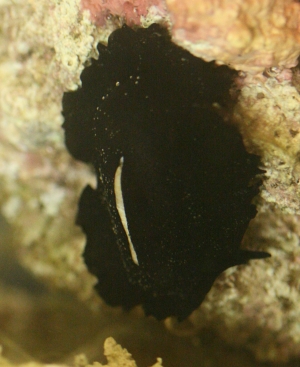
Dear Bill Rudman,
In our laboratory at the University of Helsinki we have a 300 l research aquarium, which was set up in August 2006. We bought the live rocks second hand, and got a black sea slug with them. I have enclosed a photo I took of the slug in the aquarium. Here are some observations of the slug:
-
During the 16 months it has been in our aquarium, it has grown from about 1 cm to 5 cm in length.
-
It crawls really slowly on the rocks and sometimes on the aquarium wall. The movement can hardly be detected, but every time I go to see it, it has moved to a different place. I suppose that it eats seaweed that grows on the rocks.
-
The ventral side, which is not seen in the picture, is white.
-
I have once seen the white stripe on the dorsal side to have expanded to a large irregularly shaped protruding swelling. I was able to examine this swelling closely, but when I came back after a couple of minutes, it had returned to normal. I wonder what this might mean.
-
I have no idea, what part of the world do the live rocks originally come from, but in the aquarium shop where I bought the rocks they have a pool with a lot of slugs like this. However, The shopkeeper did not know where they came from.
-
The salinity of the aquarium has been kept between 30 and 35 ppt. The temperature was originally about 23 degrees Celsius, but we have now lowered it to 19 degrees. The photoperiod is 12h/12h.
If possible, I would like to have answers to the following questions:
-
What species does this slug belong to?
-
Are there any features visible, that someone, who is inexperienced with sea slugs could use to guess in which larger taxonomic group it belongs to?
-
What is the purpose of the white stripe on the dorsal side?
-
We are planning to lower the temperature to 15 degrees Celcius for other reasons. Will our slug tolerate such temperatures?
-
How long could we expect this slug to live?
Best regards,
Sampo Tiensuu
Dear Sampo,
I am pretty sure this is a species of Scutus. Have a look at the Fact Sheet and the attached messages for more information on this animal. Until I started the Forum I did not realise just what a common hitch-hiker on 'live rock' this animal is. The white stripe which seem to get wider and thinner is an illusion caused by the black flaps sometimes expanding to cover the white shell and sometiimes contracting to expose a bit of it. The most obvious external clues to its relationships are the 'external' shell and the head tentacles and eyes which are characteristic of vetigastropod snails.
There is surprisingly little in the literature about the biology of Scutus, but as I mention above, if you have a look at the comments on the messages attached to the Fact Sheet you will find quite a bit of information. Concerning the water temperature it will tolerate. I assume this is a tropical species so it may not like too cool a temperature. Certainly temperate species in New Zealand could tolerate 15 C. All I can suggest is see what happens - or take it back to the aquarium shop.
There is a slight possibility it is cowry or an ovulid but in these groups the shell is polished and much more egg-shaped than the flat plate-like, roughened shell of Scutus.
Best wishes,
Bill Rudman
Found what I believe to be a Sea Slug or Snail in my Tank
November 28, 2007
From: Chad Naujoks
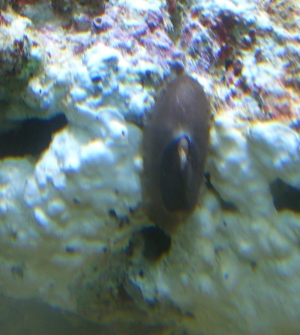
Hello!
Tonight I was checking the tank before going to bed, it is about 1am, and I saw something crawing on the rock. It seemed to be eating Diatoms (brown Algae) I am not sure that it is a Scutus due to the coloring and shape. I am going to include 3 images with this message, but they are not THAT great.
Locality: Aquarium, Aquarium, 16 November 2007 1 AM, on a new piece of live rock. Length: ~1.2". Photographer: Chad Naujoks.
Chad N.
chad@steeltide.com
Naujoks, C. B., 2007 (Nov 28) Found what I believe to be a Sea Slug or Snail in my Tank. [Message in] Sea Slug Forum. Australian Museum, Sydney. Available from http://www.seaslugforum.net/find/21139Dear Chad,
It certainly looks like Scutus to me. I am afraid only one of your photos showed any detail, if it is Scutus the white patch in your photo will be part of the white shell. Your best bet is to try and get it out of your tank into a dish of seawater - or get it to crawl on the glass - so your can see its shape better. There are plenty of photos on the Scutus Fact Sheet and in the accompanying messages to make sure of your identification
Best wishes,
Bill Rudman
Re: Scutus reproduction
May 18, 2007
From: Aubrey
Concerning message #15037:
Hello, I too have these in my tank. I have only had it up and running for two months now (past cycling). It's 56 gallon, fish only (so far), and I have 3 Scutus (don't know the correct plural, sorry).
I have three questions:
1. How fast do they grow? Because mine are growing quite rapidly.
2. Will they mate in my tank? I ask because I was only aware of one, then a bigger one showed up, and now there's a smaller one too. Largest about 2.25 inches
3. Are three of these too many for my tank?
Thank you so much for your help.
Aubrey
Texas, USA.
texanangel@hotmail.com
Aubrey, 2007 (May 18) Re: Scutus reproduction. [Message in] Sea Slug Forum. Australian Museum, Sydney. Available from http://www.seaslugforum.net/find/19915Dear Aubrey,
I'm afraid all I know about keeping Scutus in aquaria is from the Forum messages. I suspect your three animals all arrived on rock as small juveniles. They probably feed on algae in your aquarium so they may be quite useful in keeping the glass clean. As far as reproduction goes, have a look at earlier messages. These are not sea slugs so you will need to have a male and a female - and before you ask, there is no easy way to tell if you have boys or girls. My advice would be to leave them and see what happens. I can't imagine they will do any harm.
Best wishes,
Bill Rudman
Re: Scutus reproduction
February 9, 2007
From: Matthew A. Clarke
Concerning message #15037:
I think i have one in my tank it has a white bottom and sticks to the glass at night. I am just wondering are they poisonous? I know that colourful sea slugs are usually poisonous.
Thank you
Matt
mattclarke77@hotmail.com
Clarke, M.A., 2007 (Feb 9) Re: Scutus reproduction. [Message in] Sea Slug Forum. Australian Museum, Sydney. Available from http://www.seaslugforum.net/find/19414Dear Matt,
The Forum is organised so that all the messages about one topic are attached to a Fact Sheet. One of the advantages of this is that if you want to know about Scutus you can go to the relevant Fact Sheet and find a list of messages about Scutus at the bottom of the page. It doesn't take long to quickly look through the list to see if what you want to know has already been discussed. It also means I can spend time on questions I have already answered. I note that there is at least one message in the list dealing with "Is Scutus reef safe?".
Best wishes,
Bill Rudman
Scutus reproduction
October 20, 2005
From: Rob Wedin
Thanks for maintaining this little Scutus spot on the internet!
I now have two of these in my 120g reeftank. I'd love to help foster a reproduction event [see message #11385 ], but am unsure about the following:
Both Scutus are almost definitely direct siblings, from the same tank but acquired years apart. Does this hinder their mating chances?
Hermaphrodites - out of two, will one of them change to the the opposite sex, or would I have to aquire opposite-sex limpets?
Thanks again!
Rob Wedin (ribs)
rwedin@marinoindustrial.com
Wedin, R., 2005 (Oct 20) Scutus reproduction. [Message in] Sea Slug Forum. Australian Museum, Sydney. Available from http://www.seaslugforum.net/find/15037Dear Rob,
I am not sure why I encourage Scutus questions. I really have far too many sea slug questions to spend time on a little snail. However it certainly illustrates one way the Forum increases our knowledge. While I have helped a lot of aquarium people discover what this animal is, they in return have given us a lot of new information about its reproductive behaviour. While theoretically we 'knew' that it should relase its eggs and sperm into the water, I don't think it has actually been observed previously.
So to your question. I am not sure why you think your two animals are siblings. It's possible they are, but also they could have arrived on separate occasions on live rock. But to answer your question, sibling mating is not uncommon in nature. However, Scutus is not an hermaphrodite, so unless you have a male and a female, I'm afraid mating events are out of the question. And before you ask.... there is no easy way of identifying their sex - unless you dissect them - which means killing them, which would rather defeat the purpose of the exercise.
Best wishes,
Bill Rudman
Black slug thing in aquarium
October 8, 2005
From: Kristina Mahan
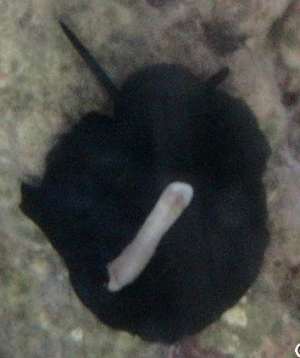
Can somebody please ID this thing-- I just need to know if he eats coral. He moves around like a nudibranch--- He up and around during the daytime . . . His white strip appears to disappear sometimes . . . Camouflage? It's about an inch long.
Kristina Mahan
kmmahan@hotmail.com
Mahan, K.M., 2005 (Oct 8) Black slug thing in aquarium. [Message in] Sea Slug Forum. Australian Museum, Sydney. Available from http://www.seaslugforum.net/find/14948Dear Krissy,
This is the slug-like snail Scutus. Have a look at the Fact Sheet and the many attached messages for more information. The white stripe is the shell, and it disappears sometimes when the black flaps of skin which enclose it, expand fully. Shouldn't be any problem for corals and probably keeps green algal film under control.
Best wishes,
Bill Rudman
Scutus snail - in aquarium
September 9, 2005
From: L. Whyte
Thanks so much for the useful information you have printed about the Scutus snail. We had a small one (less than 2.5 cm) come in on some Fiji live rock about 2 years ago. She is now approx. 7.5 cm long and 2/3 that wide. For the longest time, we thought she was a nudibranch of some sort but could neither identify her nor find any sort of information. We keep a few fish as well as an assortment corals, including leathers, soft corals, LPS corals, gorgonians, mushrooms, buttons and star polyps. She has never harmed anything in our reeftank and is a great algae eater. I wish I could get a few more like her! Anyway, thanks so much for ending a mystery for us!
L. Whyte
l_whyte@hotmail.com
Whyte, L., 2005 (Sep 9) Scutus snail - in aquarium. [Message in] Sea Slug Forum. Australian Museum, Sydney. Available from http://www.seaslugforum.net/find/14721Black And white Nudibranch?
August 17, 2005
From: Colin Winkelmann
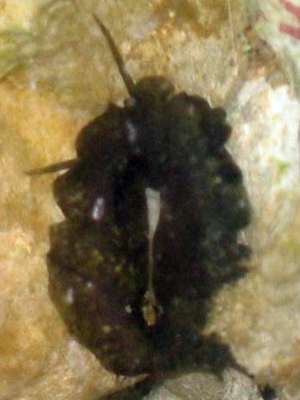
I found this nudibranch on my live rock a couple days ago, he is about 2 inches long and black with a white skunk stripe on his back, he doesnt seem to be harming anything, i just want to know what he is and what is his diet if anyone knows. He has been in the tank anywhere from 6 months to 2 months, i dont know which rock he hitched on.
please help ID him.
Length: 2 inches. Photographer: Colin Winkelmann
Colin Winkelmann
alwaysconfused666@hotmail.com
Colin Winkelmann, 2005 (Aug 17) Black And white Nudibranch?. [Message in] Sea Slug Forum. Australian Museum, Sydney. Available from http://www.seaslugforum.net/find/14573Dear Colin,
This is Scutus, which is a snail. The white stripe si in fact its flattened shell which is usually hidden or at least partially hidden by flaps of skin. Have a look at the Fact Sheet and other messages for more information
Best wishes,
Bill Rudman
Re: Is Scutus 'Reef safe' ??
March 9, 2005
From: Kingston Wong
Dr. Rudman:
Thank you for the quick reply. I found this info (that Scutus are not reef safe) in Julian Sprung's book on "Invertebrates". In his Oceanographics Series.
Kingston
king0926@aol.com
Wong, K., 2005 (Mar 9) Re: Is Scutus 'Reef safe' ??. [Message in] Sea Slug Forum. Australian Museum, Sydney. Available from http://www.seaslugforum.net/find/13291Dear Kingston,
Julian Sprung certainly has a lot of experience in aquarium keeping, but I don't know how Scutus could be a problem. Perhaps you should try contacting him for more details. I certainly don't want to lead you astray.
Best wishes,
Bill Rudman
Is Scutus 'Reef safe' ??
March 5, 2005
From: Kingston Wong
I have 6 very large Scutus in my 120gal semi-reef. Never seen them eat anything except algae. Took 2 out and put them in 100gal semi-reef tank. Now I read they are not reef safe, what do they eat besides algae?? I have mostly zoos, mushrooms, 2 bubble corals, some Monti (digitatus, and Cap), Xenia, ect. Are they really not reef safe??
Kingston Wong
king0926@aol.com
Wong, K., 2005 (Mar 5) Is Scutus 'Reef safe' ??. [Message in] Sea Slug Forum. Australian Museum, Sydney. Available from http://www.seaslugforum.net/find/13282Dear Kingston,
I don't know where you read that Scutus are not 'reef safe'. I find 'reef safe' a very strange term as it really means 'aquarium safe'. All these poor animals which have been ripped from their reefs were safe on their reefs until humans interfered - that was their environment!
Be that as it may, I am sure there is nowhere on the Forum that I have said that Scutus are a problem in aquaria.
Best wishes,
Bill Rudman
3 Scutus in my tank
February 23, 2005
From: Catalina Pampin
Hi,
a month ago I discovered the first one, now there are 3 of them. It is a 360 gallon tank with sandy botton, lots of live rock, and some soft corals, anemones, 3 stars and some fish. I have just started 10 months ago with my tank, and what do you think I should do with these critters?, let them go ahead with their lives at home or remove them somewhere else?, do you know if maybe I`ll wake up some morning and find they are everywhere ?, it seems they multiply pretty fast..., they like to wander around some Actinodiscus and a orange polyp coral, are you sure they just feed on algae?, thanks for the info.
Catalina
katy@elpastordebrie.com.ar
Pampin, C., 2005 (Feb 23) 3 Scutus in my tank. [Message in] Sea Slug Forum. Australian Museum, Sydney. Available from http://www.seaslugforum.net/find/13179Dear Cat,
I suspect your Scutus must have arrived with some rock you put in your aquarium. Just because you have just seen them doesn't mean they have just arrived or have grown very quickly. The probably have been slowly growing for months. Yes they are quite safe and only eat algae. With luck they will be nice little glass cleaners
Best wishes,
Bill Rudman
Re: Reproduction of Scutus sp.
November 14, 2003
From: Rob
Hi,
To add to earlier messages, I saw my Scutus reproducing last night. I was looking at my tank when I noticed milky substance squirting from my live rock. Upon closer investigation I saw it was a Scutus. Then I noticed the same milky, what I now know to be sperm, squirting from the other side of the tank. Ok so now we have 2 male Scutus shooting sperm into the water. A few seconds later, from in between both of them, hundreds of tiny eggs are released in the same fashion from a third (female). I guess I'll be noticing much more of these neat creatures.
I don't know if this has anything to do with it, but there was a full moon last night.
Rob
shicatshira@yahoo.com
Rob, 2003 (Nov 14) Re: Reproduction of Scutus sp.. [Message in] Sea Slug Forum. Australian Museum, Sydney. Available from http://www.seaslugforum.net/find/11385Thanks Rob,
Scutus seems to have decided its an 'honorary' slug. I certainly don't encourage Scutus messages but they seem to keep on coming - and it does seem we have learnt a bit about Scutus reproduction.
Best wishes
Bill Rudman
Identification of a Black Slug
August 11, 2003
From: Elvis
Hello,
I'm looking for an ID on a particular slug ... Here's some info, I started out with one and now have hundreds of these little creatures in my aquarium....
The slug is black, round, and has a white stripe ton the back, which gets larger, and sometimes completely closes ..... The slug has tentacles, and has black flaps on the side making it look like a flower .... I heard it's called an elephant slug, but can't seem to find it anywhere..
I'd appreciate a link to the species or what it's diet consists of..
Thank you.
Elvis
vplebowski@sbcglobal.net
Elvis, 2003 (Aug 11) Identification of a Black Slug. [Message in] Sea Slug Forum. Australian Museum, Sydney. Available from http://www.seaslugforum.net/find/10704Dear Elvis,
At the top of each page on the Forum there is a black navigation bar which includes a SEARCH button. If you had searched there for 'elephant slug' you would have got your answer. Your animal is Scutus. If you go to that page you will find plenry of background information on the Fact Sheet and the many attached messages. I am not sure how nany species there is either one black species with a widespread distribution in the tropical and temperate Indo-West Pacific, or a number of very similar-looking species. From the many messages to the Forum it is a very common hitch-hiker on 'live rock' which is sold to aqaurium keepers. Scutus is a snail, not a sea slug, and unlike sea slugs it is single sexed. Therefore you must have either had two animals in your aquarium before all the 'babies' appeared, or else you bought a piece of live rock with many microscopic juveniles on it.
Best wishes,
Bill Rudman
Scutus in aquarium
February 4, 2003
From: Charles S. Thompson Jr.
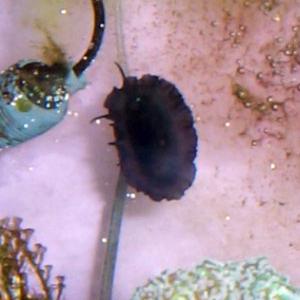
Hi,
I live in Essex Jct, Vermont and have a 38 gallon saltwater aquarium... Two years ago I was given a black sea slug from a friend who owns a local aquarium store... About a year ago I was given a second one identical to the first... I've since lost the older one due to a rock distaster in the tank which I'm very regretful of... I know nothing about these guy and would like to know what you might be able to tell me...
They are all black, mid-night black with a white foot and have a fringe around a oval body... The eyes, mouth, and "feelers" are located below the fringe... The center of the back is split and on rare occasions slightly open exposing a white colored tissue... From the older slug that died I found a flat oval shell which must be centered on the back inside the slitted back... The slugs are nocturnal coming out only in complete dark and returning home at first morning twielight... They seem to be vegetarians grazing on algie growing on the glass and any plant life I put in the tank... I hope this information helps... I'm sending photos as well... I can only guess as possible origins but my friend's live rock comes from the Fiji Islands but I don't know for sure if these two came off that rock... They were found later already moving across the glass of two different tanks...
Charles
chuck@eastcoastprinters.com
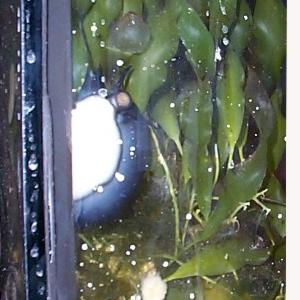
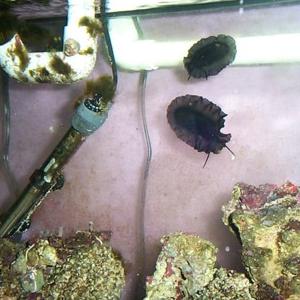
Dear Charles,
From your description and photos I am sure what you have is the slug-like snail, Scutus. If you look at the Fact Sheet on the species, and at the other messages on the page you wil find quite a bit about its biology. As you thought, it is a vegetarian, so it is quite a useful little glass-cleaner.
Best wishes,
Bill Rudman
Scutus in aquarium (2)
February 4, 2003
From: Nathan Gaub
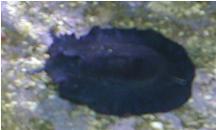
I have a 220 gal reef tank I have a creature that just showed up. It is about 1 1/2 inch long, the color is dark purple with a white slit in the back that opens up.
Looks like a mushroom with a snails head.
Nudibranch of some kind?? maybe a limpet are they safe to keep?
I have posted this request on my web site www.aquariareview.com and someone gave me this link to you
Nathan Gaub
bizonthenet@comcast.net
Dear Nathan,
Your animal is the 'slug-like' snail Scutus. If you look at the Fact Sheet on the species, and the other messages on the page, you will see it is a fairly common 'hitch-hiker' on 'live rock'. It is also a useful glass cleaner in aquaria.
Cheers,
Bill Rudman
Re: Black seaslugs in reef tank
January 11, 2003
From: Brett T Lynch
Dear Dr. Rudman,
Thanks for your reply!!
While atinic lights are on, and just after the white lights turn off the Scutus's all find a high point on a rock or even the glass. One consistent thing I notice when they spawn is their bodies are 120 degrees, or should I say diagonal, with their heads up. They shoot a white transparent milk that appears to have very little white beads. The fact that they are diagonal when they release seems to propel the 'milk' farther away from themselves. The really amazing thing is like graduation caps they all release there eggs|sperm in one big burst. Also some of the slugs release a thick pure white "half and half" type release unlike the other which release what I described. So in other words one seems like the eggs and the other the sperm? Also I think you are right as well about them eating a Pocillopora I had, they where just after the algae deep in the fingers, Thanks for your Knowledge and time Dr Rudman,
Brett T. Lynch.
Lmeinken@juno
Thanks Brett,
Your observations about synchronous spawning are very interesting. In nature, we normally assume that synchronous spawning, is cued by some environmental factor such as the phases of the moon, salinity changes, length of light-dark cycles etc. It is interesting to know that in Scutus spawning can be synchronised by some factor unaffected by the artificial environment.
Cheers,
Bill Rudman
Black seaslugs in reef tank
January 9, 2003
From: Brett Lynch
Dear Dr. Rudman,
I have a reef tank for almost ten years now and as long as i can remember I've had these black seaslugs. They grow to about an inch and have a white stripe down their back and can cover it up with their frilly black cape?. They have two prominent anttenae. They don't feed on my corals except a pink Pocillopora (sps) which they devoured in one night. Most of my corals are LPS'S and are from Bali, Indonesia area. The black slugs readily spawn. All 15 spawn at once right after the white lights goes out. These slugs have a cartilige hardness I can feel when I remove some due to their proliferation, weird, like squid bones?? They only come out at night and wait under rocks till the brightest lights go out. When I ask my dealer he explained that they where in the snail family, but I can't find any information on them. Also I have no algae problems since my guests have had a strong hold?
Please help,
Brett Lynch
Lmeinken@juno.com
Dear Brett,
From your excellent description I am certain your animals are a snail called Scutus If you have a look at the Fact Sheet you will see the white line you describe is in fact part of its flattened shell. I'm glad to hear that since you've had these beasts you have no algal problems, because if you look at the earlier messages on the page from other aquarium keepers, you will see I suggest that Scutus might help with unwanted algal film on the glass and rocks. I am a bit surprised by your comment about them eating a coral colony. Is it possible the colony was already dead and they were eating the algal film which would grow quite quickly on the skeleton?
I am interested in your comment on spawning. Does that mean you have seen them releasing eggs and sperm into the water? Is it a milky cloud? You'll see I have just recently explained how they spawn in answer to another message.
Best wishes,
Bill Rudman
Reproduction of Scutus sp.
January 7, 2003
From: Timothy D. Loyd
Dear Dr. Rudman,
Concerning my mention mention of Scutus populating our aquaria. Unfortunately there is not much I can tell you about how the limpets are reproducing in our reef tanks. We have several large systems with many individual tanks as well. When I first e-mailed you about this, there was only one that I had noticed. Now they are in every tank and they are varied in size. I have not noticed any contact between individuals of the species, nor have I observed any unusual egg masses. If I ever notice anything relative to there reproduction, you will be the first to know. On another note, The only thing that reproduces more than the limpet is the multi-perforated abalone snail (Haliotis multiperforata). I have so many of these little snails that I could repopulate the ocean if need be.
Thanks,
Tim
tim@aquariumconnection.com
Thanks Tim,
On reflection, I should have realised that in a large scale system like yours, the appearance of a large population of a species could easily mean that the species is a good hitch-hiker rather than a good aquarium breeder. In the case of Scutus and Haliotis it could be a bit of both. Like all vetigastropod snails, they have separate sexes, so need at least one individual of each sex for breeding, but like many primitive snails, fertilisation is external, eggs and sperms being releasd into the water. The veliger larvae ar lecithotrophic, meaning they do not feed while in the plankton. As long as a you have a few individuals in an aquaria, it is quite possible that they could successfully breed.
Best wishes,
Bill Rudman
Sea slug in my tank?
October 1, 2002
From: Daniel R
I am 15 and own a 12 gallon, full blown mini reef. I have had it running for a few months now and just about 20minutes ago we found a small, what appears to be a nudabranch. It is black, and has a white "stripe" down the middle of it which gets larger and smaller as the light changes. it is about the size of a penny. any info is appreciated.
Thanks in advance,
Daniel
4roses@citlink.net
Daniel, 2002 (Oct 1) Sea slug in my tank?. [Message in] Sea Slug Forum. Australian Museum, Sydney. Available from http://www.seaslugforum.net/find/8084Dear Daniel,
This is an easy one. Go to the Scutus Page to find out about your animal. As well as the Fact Sheet, have a look at other messages below yours on the page as they have further information. Basically your animal is a called which has a flattened white shell on its back which is partially or fully covered by flaps of skin. It seems to be changing size, but the white stripe is the part of the shell you can see. It gets wider and thinner as the black flaps of skin open and close a bit.
Best wishes,
BillRudman
Another Scutus in an aquarium
September 27, 2002
From: Tae Kim
I am trying to identify whether or not the organism in my acquarium (which came with some live rocks from the pacific) is a nudibranch, and if it is what type. It is all black - velvety black with a thin very white slit on top. It's outer edges are ripply and soft looking. Can you let me know which species I might look at to see if I have a match. ALso should I be worried about the harm it may do to my acquarium enviroment or its inhabitants.
Your help would be much appreciated.
Thank you
Tae Kim.
tae.kim@royalphone.com
Tae Kim, 2002 (Sep 27) Another Scutus in an aquarium. [Message in] Sea Slug Forum. Australian Museum, Sydney. Available from http://www.seaslugforum.net/find/8050Dear Tae Kim,
From your description I am pretty sure your animal is Scutus. Have a look at earlier messages on Scutus for background information. It shouldn't harm your aquarium and may in fact help keep the glass clean
Best wishes,
Bill Rudman
Scutus - Thanks
April 25, 2002
From: Becky
Dear Dr. Rudman,
Thank you so much for identifying Scutus for me. I see that quite a few other people had problems identifying this creature besides me. The picture you posted is an exact replica of my little "cootie", who by the way, is thriving and has gotten less shy. He inhabited the dark corners of the aquarium for about 4 months, but has since become much bolder. I will have had him a year come summer and I have really enjoyed watching him. Thanks again, you were very helpful. Becky.
beckya@times-press.com
Becky, 2002 (Apr 25) Scutus - Thanks. [Message in] Sea Slug Forum. Australian Museum, Sydney. Available from http://www.seaslugforum.net/find/6801Thanks Dr Rudman
March 20, 2002
From: Pippa Styles
Dear Dr Rudman,
I found your Forum while researching a project for my 6 year old son who had found an elephant slug on a school trip to the rocky shore near Auckland. I found all the information that I needed on your great web site and just wanted to say thanks very much, it really helped and answered all our questions.
Pippa
pippa_styles@hotmail.com
Styles, P., 2002 (Mar 20) Thanks Dr Rudman. [Message in] Sea Slug Forum. Australian Museum, Sydney. Available from http://www.seaslugforum.net/find/6475Another Scutus in live rock
March 5, 2002
From: Becky
I am a novice reef keeper on a small scale (20 gal.) and I have been trying to identify a slug type creature that came in on some live rock I purchased for my tank 6 months ago. It appeared to be a hole - until it moved. Most of the time it is disc shaped although it can elongate. It can ruffle its edges and looks like a snail from the underneath (when it's on the glass). It usually has a hump in the center and has 1 white stripe down the back, although it can vary the thickness of this stripe to the point of disappearance when it wants to. It seems to be able to contort its body to any shape or dimension necessary to conceal itself in live rock. For a long time it would not come out into the light, but it seems to be less shy now. I think it eats slime algae as I see it frequently attatched to the glass. I have 2 azure damsels (1.5" ea.), 1 percula clown (1.75"), 1 green mandarin, small red hermits, small algae snails (astrae), & 2 emerald crabs. None of the other residents seem to bother this black creature, although for a long time he seemed to be fearful. My primary interest is how safe this creature is. Eventually, I plan on adding some leather corals & mushrooms. Do you think this black thing will bother them? I don't have a picture & have looked in vain on the slug pages for something resembling this creature.
Becky
beckya@times-press.com
Becky, 2002 (Mar 5) Another Scutus in live rock. [Message in] Sea Slug Forum. Australian Museum, Sydney. Available from http://www.seaslugforum.net/find/6361Dear Becky,
You don't say where your live rock came from but I suspect your animal is animal is Scutus, a 'snail' rather than a 'slug'. The white stripe you can see on its back is part of its flat white shell, which appears to vary in size because it is partially covered by a flap on each side of the body, which can expose or cover the shell as it extends or contracts. Have a look at the photos on the Fact Sheet. Scutus seems to be a common 'hitch-hiker' on live rock and seems to thrive in home aquaria feeding, as you suspect, on algal film. Far from being a problem in your aquarium, it could be a useful addition to your tank.
Best wishes,
Bill Rudman
Trying to ID black slug
November 20, 2001
From: Mark Conley
I have at least two black slugs in my reef aquarium. They seem mostly nocturnal, though I occasionally see them during the day. They have a two segemented foot and similar mouth to a snail and have the same coloration of astrea snails on the foot and mouth parts pink/peach. They are the size of a thumb and have a frilly fringe around the body. They also have a slit on thier back that opens to show white. They are otherwise completely back on top. The also have antenna that protrude from under the fringe at the head. They also appear to graze on algae. Any information on this interesting species is greatly appreciated.
Mark
mustango656@hotmail.com
Conley, M., 2001 (Nov 20) Trying to ID black slug. [Message in] Sea Slug Forum. Australian Museum, Sydney. Available from http://www.seaslugforum.net/find/5673Dear Mark,
From you description I am pretty sure you have the slug-like snail Scutus. The white bit you describe on its back is in fact its plate-like shell which is usually partly covered by flaps of skin. Have a look at the top of the page your message is on for some photos and geeral information, and have a look at the messages below yours for other messages and my comments.
best wishes,
Bill Rudman
Re: Mystery black Sea Slug
November 8, 2001
From: John Strawn
Dear Bill,
Concerning your reply. It is indeed Scutus sp.!!!
Thanks a million!
John
johnstrawn@hotmail.com
Strawn, J., 2001 (Nov 8) Re: Mystery black Sea Slug . [Message in] Sea Slug Forum. Australian Museum, Sydney. Available from http://www.seaslugforum.net/find/5651Mystery black Sea Slug
November 7, 2001
From: John Strawn
I sincerely hope that someone can find time to reply to my query. I have discovered a most unusual sea slug in my saltwater aquarium. I was unable to take a picture, but a verbal description can give a very precise description. The slug was about 1" in diameter, quite flat, a perfect circle, and pitch black!!! It was the most extraordinary thing I have ever seen. I turned on the light and the slug quickly made itself scarce. This is obviously a nocturnal slug. It's rhinophores were also quite far apart. I'm thinking that this may perhaps even be an unidentified species due to it's camouflage and nocturnal nature. Please get back to me if possible.
Thanks,
John Strawn
johnstrawn@hotmail.com
Strawn, J., 2001 (Nov 7) Mystery black Sea Slug. [Message in] Sea Slug Forum. Australian Museum, Sydney. Available from http://www.seaslugforum.net/find/5637Dear John,
I'm afraid you don't give me a lot of information to work from other than the colour. One animal that does turn up quite often in saltwater aquariums, especially if you have added 'live rock' is the slug-like snail Scutus. Have a look at the information above your message on Scutus, and at the other messages below yours on this page.
If it is a true slug it will havea circle of gills on its back. If so, then it is possibly Dendrodoris nigra or Dendrodoris funata.
Best wishes,
Bill Rudman
Re: Aquarium mystery
September 1, 2001
From: Jay Rundle
Dear Bill
Thanks for the response ... It looks like your ident is right on. Yes, it did come from live rock. I will definitely keep it.
Thanks again.
Jay Rundle
jay.p.rundle@xo.com
Rundle, J. P., 2001 (Sep 1) Re: Aquarium mystery. [Message in] Sea Slug Forum. Australian Museum, Sydney. Available from http://www.seaslugforum.net/find/5185Can you identify this Sea Slug?
August 31, 2001
From: Jay Rundle
I have a salt water aquarium and just noticed a type of sea slug I cannot identify moving along a rock. It is about 1 inch long, flat and oval in shape, two short stubby antenae, black in color.
Questions: (1) is this a danger to the other animals in the tank, (2) what is the name of this wonderful little creature?
Jay Rundle
jay.p.rundle@xo.com
Rundle, J., 2001 (Aug 31) Can you identify this Sea Slug?. [Message in] Sea Slug Forum. Australian Museum, Sydney. Available from http://www.seaslugforum.net/find/5169Dear Jay,
You give me no idea where the animal came from. If, as I suspect, it hitched a ride into your aquarium on some 'live rock' then it is probably Scutus, which if you have a look at the top of this page and also at the messages below yours, you will see is not a slug at all but a snail which hides its shell under two flaps of skin. If it is Scutus then it will be eating an algal film in your tank and so is a useful little addition to your artificial ecosystem.
Best wishes,
Bill Rudman
Mystery Sea Slug is Scutus
June 12, 2001
From: Marve Wiessner
I have a reef aquarium which I have purchased some live rock for. After a few months I have noticed a creature which resembles a snail type of animal. I was told that it may be a sea slug. It is probably the size of a quarter. It is totally Black with a white slit down its back. It seems to be more round than oblong. Its back is raised kind of like a hump. Its skirt or canopy covers it entirely including the head and antenna. It doesn't seem to be doing any harm. I am wondering if someone could lead me in a direction to find out a name and if it is an ok slug to leave in the tank. Any help would be greatly appreciated.
Thank You
Marve Wiessner
mwiess@poboxes.com
Wiessner, M., 2001 (Jun 12) Mystery Sea Slug is Scutus. [Message in] Sea Slug Forum. Australian Museum, Sydney. Available from http://www.seaslugforum.net/find/4557Dear Marve,
Your description makes this an easy one to identify. It is a species of the slug-like snail Scutus. Have a look at the top of this page and the messages below yours for more information on this animal.
The white slit you see is in fact part of its flattened white shell which is almost completely hidden by skin flaps. It is a herbivore so rather than being a problem will probably be a help in keeping a green algal film from growing over rocks and the glass.
Best wishes,
Bill Rudman
Flatworm? Scutus? I.D. Help Needed
April 21, 2001
From: Matt Anderson
HI,
I just received some live rock from someone and while packing I noticed a small flat black creature. It looks a little like a nudibranch (sp), Its about 1 - 1 1/2" long. He called it a Flatworm. Someone else said it might be a Scutus. I am trying to find a little more info on this critter.
TIA,
Matt Anderson
lakedawgs@netscape.net
Anderson, M., 2001 (Apr 21) Flatworm? Scutus? I.D. Help Needed. [Message in] Sea Slug Forum. Australian Museum, Sydney. Available from http://www.seaslugforum.net/find/4197Dear Matt,
I can't help without a description or a photo. If it's black have a look at the page on Scutus. If you read some of the information there you should be able to identify Scutus if that's what you have. Also have a look at the Flatworm Pages. On the off-chance that it is a nudibranch, have a look at the Dendrodoris nigra Page, as that species is a black nudibranch which does hitch around on live rock.
Best wishes,
Bill Rudman
Is this some slug or a limpet?
December 30, 2000
From: Kristen Chinn
Hi, I just bought some live rock and noticed a "slug" crawling around. I posted videos and pictures at the sight below and people seem to think it's a keyhole limpet Scutus unguis. But I can't find any information on this creature.
http://www.reefcentral.com/vbulletin/showthread.php?threadid=9297
Do you have any ideas or information you can give me?
Thanks,
Kristen
klchinn@ucdavis.edu
Chinn, K., 2000 (Dec 30) Is this some slug or a limpet?. [Message in] Sea Slug Forum. Australian Museum, Sydney. Available from http://www.seaslugforum.net/find/3292Dear Kristen,
Your animal certainly looks like a species of Scutus. Have a look at the general information at the top of this page and the messages below yours for more information.
Best wishes,
Bill Rudman.
Help with ID.. aquarium mystery
December 28, 2000
From: Tim Merkel
Hi everyone!
I am just starting a new reef tank and added some base rock from the LFS. This tank is 4 days old and I am in the process of starting the cycle. As I turned over the "dead" base rock before putting it into the tank my heart stopped. There was a black sluglike thing really, really close to my finger. After reading the information on the website I am not so afraid. :) As most of the slugs seem to require a specialized diet and I am just now starting the cycle on the tank would you recommend me taking it back to the fish store to give it a fighting chance?
Before I do could someone let me know what kind it is? It is just plain black and completely smooth. There does seem to be a 1/4 to 1/2 inch white dash/line down the middle of its back. I didn't see any other features as it is hiding in the shadows.
Any information you could give me would be appreciated. If you can identify it could you let me know what food it eats? I would like to tell the LFS.
Sincerely,
Tim Merkel
tecumseh@toast.net
Merkel,T., 2000 (Dec 28) Help with ID.. aquarium mystery. [Message in] Sea Slug Forum. Australian Museum, Sydney. Available from http://www.seaslugforum.net/find/3378Dear Tim,
From your description I think you have a slug-like snail rather than a sea slug. Have a look at the information on Scutus and look at the other messages on the subject below yours. You will see that the white line is in fact part of the shell which is hidden by two flaps of the body.
Scutus seems to be quite good at hitching a ride on live rock. It should cause no problem in your aquarium and may in fact help keep the glass clean by grazing on algal growths.
Best wishes,
Bill Rudman.
re: Black nudibranch
September 16, 2000
From: Gareth Trinko
That's it!
Thank you for your time.
Gareth
gareth@indepmtg.com
Gareth Trinko, G. , 2000 (Sep 16) re: Black nudibranch. [Message in] Sea Slug Forum. Australian Museum, Sydney. Available from http://www.seaslugforum.net/find/3030Black nudibranch?
September 15, 2000
From: Gareth Trinko
I work at a pet store part time. We have had a 54g salt water tank setup for about 16 months. I think we started with only a few of these black nudi's. Now there are about 15-20. They don't seem to be causing any harm and they are pretty cool to have in there. Do you know what kind they are and how they reproduce? The current tank does not have a skimmer. I would like to put a few in my tank (has a skimmer) and possibly breed them. They are dark black with a 'crack' down their 'backs'. It is white in the crack. Any info would be appreciated.
Thank you,
Gareth
gareth@indepmtg.com
Trinko, G. , 2000 (Sep 15) Black nudibranch?. [Message in] Sea Slug Forum. Australian Museum, Sydney. Available from http://www.seaslugforum.net/find/3023Dear Gareth,
I am pretty sure you have a species of Scutus, which is a slug-like snail quite closely related to animals like the abalone (Haliotis) and slit limpets. If you look at the other messages on the Scutus page you will see you are not the first person to have this animal appear in their aquarium. What seems to happen is that they are transported into aquaria on weed covered rocks as microscopic juveniles, and as algal grazers find plenty to feed on in most aquaria.
Members of the Superfamily Fissurelloidea, to which they belong, have separate sexes and external fertilisation. That is they broadcast their eggs and sperm into the water and let nature take its course. Fertilised eggs develop into veliger larvae which are non-feeding (lecithotrophic) and so short-lived. It is therefore possible they could breed in your aquarium but I suspect a skimmer would not be a good idea as it could filter out the larvae.
Best wishes,
Bill Rudman.
Solid Black Sea Slug
August 16, 2000
From: Timothy Loyd
I am having trouble identifying a nudibranch that was attached to a rock I got for my reef tank. I need to identify it so that I may provide it with a food source if possible. I believe the rock it came in on was of Pacific origin. It is oval in shape, with ribbon-like lobes aroung the edges of it's body. It has a white shell just beneath the parapodial flaps running down the center of it's back. It is solid black, except for the shell and has a single pair of tubular extensions on the top of it's head. Sorry I can not provide a picture. Any information would be appreciated.
Tim
loyd1123@aol.com
Loyd, T., 2000 (Aug 16) Solid Black Sea Slug. [Message in] Sea Slug Forum. Australian Museum, Sydney. Available from http://www.seaslugforum.net/find/2888Dear Tim,
Have a look at the photos of Scutus at the top of the page. If you look at earlier messages below yours on this page, you will see others have found this animal in their aquaria.
If you read what I say above, you will see it is not a sea slug but a marine snail which has become slug-like by reducung the size of its shell and covering it with flaps of skin. (See the What is a Slug page for a bit more general information.
Should you keep it in your aquarium and what should you feed it? Although you don't mention it size, I guess it has grown in your aquarium to a visible size so there is clearly food in there for it to eat. It is an algal feeder so I suspect it will be feeding on the algal film which tends to grow in most aquaria. My advice would be to let it grow. It may not be a thing of beauty but it will certainly help keep your tank clean.
Best wishes,
Bill Rudman.
Aquarium mystery
December 11, 1999
From: Kelly Greco
Dr. Rudman:
I have recently set up a reef aquarium. A couple of nights ago, I noticed a pair of what I believe to be some type of a sea slug grazing for algae (I assume) on the live rock. Tonight, I noticed a second of the same species. I am hoping you might help me to identify it. It obviously was introduced into the aquarium with the live rock which is from Fiji. The specimens in question show no type of an obvious gill, and do not swim freely but rather crawl over the rock at night. I have, therefore, only observed the dorsal side of the animal.
Description: Black (as night!!), oval shaped, approx. 2.5 cm in length, 2 cm in width. The main body is rather small ( < 1 cm) with the mantle (??) radiating outward as a skirt. There is a slit on the dorsal side which runs the length of the body and I believe is the anus as I have seen excrement being eliminated from it. At the anterior end, I can see two antennae extending from beneath the skirt or mantle. There seems to be a mouth similar to other herbivorous molluscs (such as Astrea sp.) That is also at the anterior end.
Again, I havent been able to observe the ventral side of the animal. Judging by it's locomotion, I would guess that it has a molluscan foot.
Any ideas??!! Any input is greatly appreciated.
Sincerely,
Kelly Greco
Portland, Oregon USA
kjgee@earthlink.net
Greco, K., 1999 (Dec 11) Aquarium mystery. [Message in] Sea Slug Forum. Australian Museum, Sydney. Available from http://www.seaslugforum.net/find/1668Dear Kelly,
If you could send me a photo or even a rough drawing it would raise my answer above that of a stab in the dark. One possibility is that it a species of Scutus, which is a slug-like snail, vaguely related to animal like the abalone, Haliotis. There is a photo of Scutus on the 'What is a Slug?' Page. If it is Scutus you will find an elongate white shell hidden beneath the two flaps which form the slit on its back.
Another possibility is a Sea Hare like Dolabrifera bit that is not quite the shape or colour that you describe.
If your animals are not like Scutus then I think I will need a picture - either photo or drawing to me of much help. If you can't scan an image to send then send it to me by mail at:
Australian Museum
6 College St,
Sydney,
NSW 2010
Australia.
Best wishes,
Bill Rudman.
What is Scutus?
June 20, 1999
From: Deepak G Sarin
Dear Sir/Madam,
I would like to have a detailed information on Scutus as fast as possible on my E-mail or any information on where I could get this information.
regards,
Deepak Sarin
India
dsarin@hotmail.com
Sarin, D.G., 1999 (Jun 20) What is Scutus?. [Message in] Sea Slug Forum. Australian Museum, Sydney. Available from http://www.seaslugforum.net/find/958Dear Deepak,
Scutus is not a slug but a marine snail with a white shield-like shell on its back. There is some information on the What is a Slug? Page. For further information you would need to look at a good malacology text. It belongs to the family Fissurellidae which includes the Slit-Limpets and Keyhole Limpets so named because their limpet-shaped shells have either a slit or apical 'keyhole' to allow the discharge of exhalant water from the mantle cavity. Scutus has just a notched shell.
Bill Rudman.
